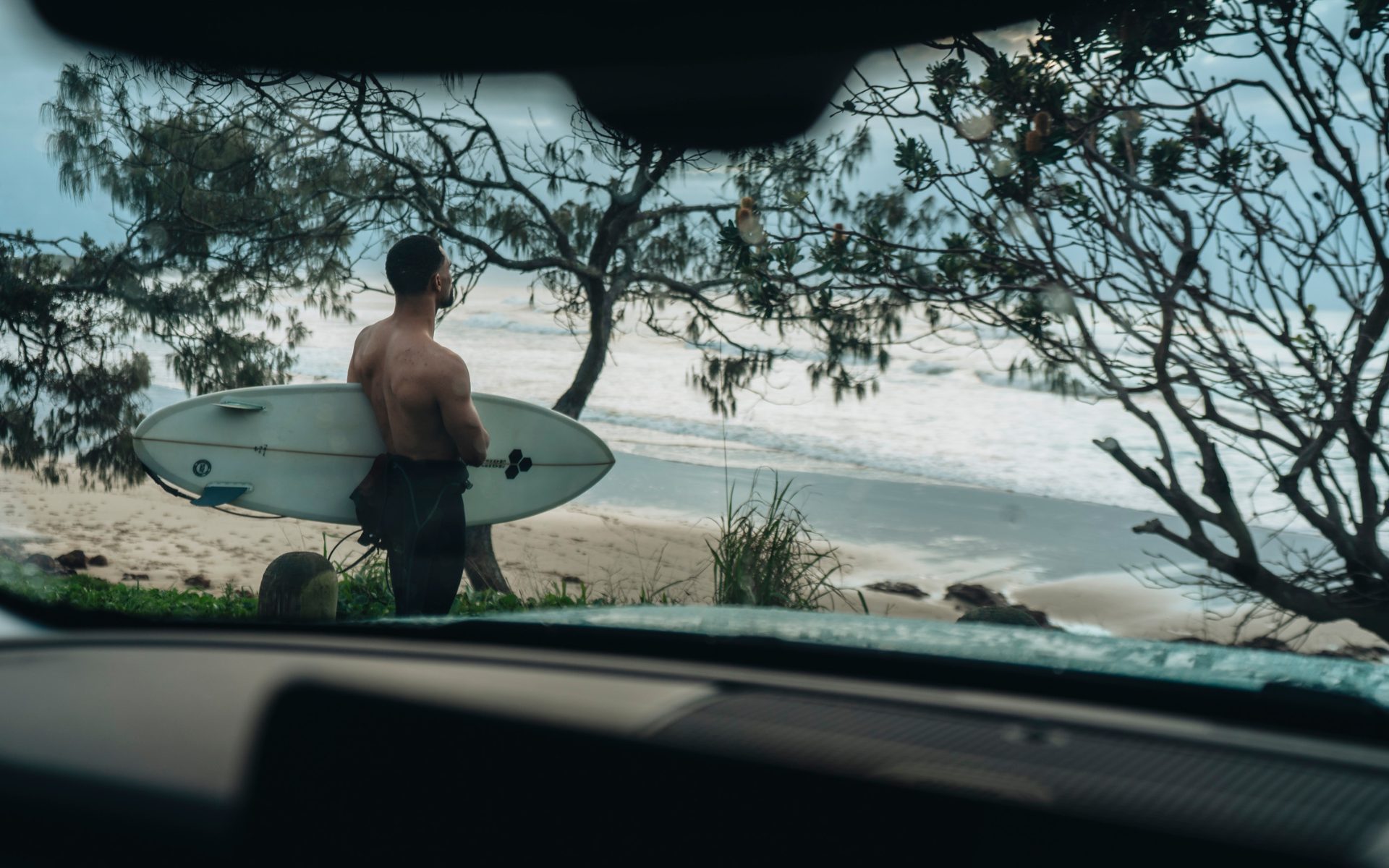After years spent living abroad, writer Emily Barlow goes looking for a way to reconnect with her home state of New South Wales, Australia. On an electric-powered journey from Sydney to Byron Bay, she stops for surf, SUP-adventures and lessons from the land.
When the paperbark tree blossoms, it means the mullet fish are running up the creek from colder waters. When the tree bark sheds, it means sharks are prevalent in the deep ocean.
“We’re saltwater, freshwater people. We’ve got a lot of relations with the fish and plants that coincide with the water,” says our stand-up paddle boarding guide, Gumbaynggirr and Yirrganydji man, Ronan Singleton.
Though I’ve called Eora/Sydney home for most of my adult life, there are many sections of Australia’s famed east coast that I’ve never explored. And many things, like the traditional Indigenous uses of the paperbark tree, that I never learned. Until now.
I’m back in Australia—after living abroad in Canada—and hitting the road in the new all-electric Jeep Avenger with my surf-obsessed friend Ari Halder to learn more about the coast and Country. The chosen route: Gadigal land (Sydney) all the way up to Bundjalung country (Byron Bay), stopping for surf, SUP’ing and sleeping at EV-friendly Reflections Holidays along the way.
The weather is not exactly ideal—the region’s been flooding and even now, it’s raining. But ever the optimists, we pack our swimmers and a surfboard into the charged EV and hit the road, keen for that post-storm swell. We’re connected to the Avenger’s infotainment in an instant, so it’s maps at the ready, music pumping and high vibes.
Three hours north of the city, the Lakes Way scenic drive—stretching between Buladelah and Tuncurry—is more than scenic. For the unoriented, picture towering eucalyptus above winding roads, and cabbage tree palms and ferns coating the damp forest floor. Birds chirp animatedly. I’m impressed by how much grip and control we have as we cruise the tight bends.
We’re on the traditional lands of the Worimi Nation, made up of 18 tribes whose lands span inland to the coast.
Our destination today is Bonny Hills, just an hour’s drive north. But a short drive doesn’t mean there’s less to do. Gazing at long stretches of rugged coastline brings down the tempo of any given day, and you can slow it down even further by stopping at Crowdy Bay National Park to check out its vast golden sand beaches and scrubby headland walking loops. Opening the Avenger’s sun roof to experience the silence of driving an EV is a must.
Bonny Hills’ verdant seaside landscape is the traditional lands of the Birpai people, an area rich with littoral rainforests, brahminy kite birds, eagles and fish. Lobsters, oysters and pipis were traditionally eaten here, while crab is a sacred salt water totem (spiritual emblem). What was once an undisturbed coast—as Birpai people settled in small villages along rivers and lakes—became decorated with wooden fishing shacks for local fishing enthusiasts in the 1940s, and is now home to large beach houses that shelter Bonny Hills’ small but tight-knit community. Still, there’s only one pub, a couple of cafés, and a whole lot of chill.
The ocean bellows directly below the headland, and a walking trail from the Reflections Holidays Bonny Hills park—our stay for the night—provides easy access to Rainbow Beach and continues along the coast to Port Macquarie.
“It’s absolutely cooking!” yells Ari as the exposed point break comes into view and the sun peeks through. Stoked on the clear conditions and a beach less crowded than his Sydney local, Ari’s got his board out of the roomy boot and his wetsuit on before I’ve turned the car off. Turns out the Bonny Hills secret is good swell.
We didn’t want to camp on this road trip, but hotels feel too removed from local life. My sleek, timber-lined cabin, surrounded by succulents, is the best of both worlds: Comfortable, but close to nature. After washing off the drive and the salt water, I have one of my best night’s sleep in ages, listening to the soundtrack of waves.
“Giinigay” (hello) says Ronan as he hands me a paddle and a soft paperbark leaf, inviting me to breathe in its eucalyptus scent. It’s immediately calming.
We’re embarking on a Wajaana Yaam SUP adventure up Moonee Creek on the Coffs Coast, the traditional land of the Gumbaynggirr people. As we push from the shore and start paddling, Ronan points out various bird species—eastern osprey and white-belly sea eagles are common—plus all the types of mangroves.
After the recent flooding, the mangroves’ important role in filtering dirty water and preventing soil erosion is even more apparent. And when I notice the way the tides flow in and out of their webbed and winding roots, how the mud crabs bunker down in the soil nearby, how mangrove jacks and estuary codfish flutter near the banks, I can’t help but appreciate the incredible ecosystem they foster.
We’re keen to spin the Avenger on the hills again, so we take a short drive through a river crossing, arched gnarled trees and farmland to visit Killen Falls. From a platform overlooking the raucous cascade, we gaze up to the sprawling canopy and down at the moss-laden rocks by the pool below.
On a warmer day, I’d take a dip in those waters, but today, it’s enough to cautiously move behind the veil of the falls to feel its rupture. The spray on my skin and the overwhelming sound drowns out all else, and I can’t stop my grin despite my now soaking trousers.
Though floodplains deterred us, this trip has reminded me how beautiful home can be at any time of year. When the sun breaks through, it’s blissful. But even without it, this 470-mile (750-kilometer) journey has shown me not only the ease of EV travel, but how resilient, adaptive and diverse the east coast landscape and its deep-rooted communities are.

